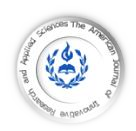
GENERAL INFORMATION
| HOME | ABOUT US | ARCHIVE | AIMS AND SCOP | AUTHORS | REVIEW | SUMIBMIT MANUSCRIPT | EDITORIAL BOARED | PUBLICATION FEE |

| HOME || ABOUT US || ARCHIVES || AIMS AND SCOP || AUTHORS || REVIEW|| SUBMIT MANUSCRIPT || EDITORIAL BOARD |

| Info-AJIRAS-® Journal ISSN 2429-5396 (Online) / Reference CIF/15/0289M |
American Journal of Innovative Research & Applied Sciences

|
American Journal of innovative
Research & Applied Sciences
Research & Applied Sciences
ISSN 2429-5396 (Online)
OCLC Number: 920041286
OCLC Number: 920041286

Authors Contact
*Correspondant author and authors Copyright © 2024:
| Waindim Yisa Tufoin Albert 1 | Tse Sparthan AZOH 2 | and | Yakum Reneta Nafu 2 |
Affiliation.
1, The University of Bamenda | Department of Mechanical Engineering, H.T.T.T.C. | Bambili | Cameroon |
2, The University of Bamenda | Department of Agricultural and Environmental Engineering, COLTECH | Bambili | Cameroon |
This article is made freely available as part of this journal's Open Access:
| https://doi.org/10.5281/zenodo.11312642 |
*Correspondant author and authors Copyright © 2024:
| Waindim Yisa Tufoin Albert 1 | Tse Sparthan AZOH 2 | and | Yakum Reneta Nafu 2 |
Affiliation.
1, The University of Bamenda | Department of Mechanical Engineering, H.T.T.T.C. | Bambili | Cameroon |
2, The University of Bamenda | Department of Agricultural and Environmental Engineering, COLTECH | Bambili | Cameroon |
This article is made freely available as part of this journal's Open Access:
| https://doi.org/10.5281/zenodo.11312642 |

| ISSN: 2429-5396 (e) | https://www.american-jiras.com | |
| Web Site Form: v 0.1.05 | JF 22 Cours, Wellington le Clairval, Lillebonne | France |
| Web Site Form: v 0.1.05 | JF 22 Cours, Wellington le Clairval, Lillebonne | France |
Abstarct7-December-2023

| MAY 18 | ISSUE N° 5 | 2024 |
| ARTICLES | Am. J. innov. res. appl. sci. Volume 18, Issue - 5 Pages 55-62 (May, 2024)
| ARTICLES | Am. J. innov. res. appl. sci. Volume 18, Issue - 5 Pages 55-62 (May, 2024)

ABSTRACT
Background: The utilization of petroleum-based lubricants in metal forming processes often results in the formation of oxide layers on extruded materials due to elevated temperatures and chemical reactions between the base metal and certain components in the lubricant. This phenomenon compromises the surface quality of the final product. Additionally, the non-biodegradable nature of these lubricants contributes to environmental pollution. Objective: This study aims to investigate the lubricating properties of Savon (laundry soap) blended with de-oiled Jatropha cake additive as a solid lubricant in direct cold extrusion of aluminum alloys. Methods: Jatropha seeds were dried and processed into powder with a particle size of 0.5 μm, followed by de-oiling using the Soxhlet Apparatus within a temperature range of 65°C to 85°C. Savon soap and de-oiled Jatropha cake were blended in varying ratios (90:10, 80:20, 70:30, 60:40, and 50:50) to produce solid lubricant blends denoted as S1, S2, S3, S4, and S5, respectively. De-ionized lukewarm water was used in a 50:50 ratio for blending. An aluminum alloy A6063 billet was machined from a cast dimension of φ26mm x 26mm to test dimensions of φ25.4mm x 25.4mm. A heat-treated axial split steel die with dimensions φ60 mm in diameter and 60mm in length, featuring a tapered entrance of φ16mm and an exit diameter of φ30 mm, was employed in the extrusion rig. The Savon-Jatropha lubricant blends were utilized during the direct cold extrusion process on a 2000-capacity UT CO821 machine. A ball-disc type Tribometer was utilized to determine the coefficient of friction for the five solid lubricant samples. Results: The findings revealed that the lowest extrusion force of 155.43KN was achieved with lubricant blend S3 (70:30). Furthermore, friction results indicated that lubricant sample S3 (70:30) exhibited the lowest coefficient of friction at 0.717. Conclusion: Based on these results, it can be concluded that lubricant blend S3 (70:30) demonstrates superior suitability as a lubricant for cold extrusion of aluminum alloys. It is recommended that the mixture of Savon and de-oiled Jatropha cake be processed and stored in dry form to prevent oxidation, and application should occur only when needed for aluminum extrusion. This approach enhances the shelf life of the solid lubricant.
Keywords: Lubricant Blends; Ball-Disc Tribometer; Friction; Force.
Background: The utilization of petroleum-based lubricants in metal forming processes often results in the formation of oxide layers on extruded materials due to elevated temperatures and chemical reactions between the base metal and certain components in the lubricant. This phenomenon compromises the surface quality of the final product. Additionally, the non-biodegradable nature of these lubricants contributes to environmental pollution. Objective: This study aims to investigate the lubricating properties of Savon (laundry soap) blended with de-oiled Jatropha cake additive as a solid lubricant in direct cold extrusion of aluminum alloys. Methods: Jatropha seeds were dried and processed into powder with a particle size of 0.5 μm, followed by de-oiling using the Soxhlet Apparatus within a temperature range of 65°C to 85°C. Savon soap and de-oiled Jatropha cake were blended in varying ratios (90:10, 80:20, 70:30, 60:40, and 50:50) to produce solid lubricant blends denoted as S1, S2, S3, S4, and S5, respectively. De-ionized lukewarm water was used in a 50:50 ratio for blending. An aluminum alloy A6063 billet was machined from a cast dimension of φ26mm x 26mm to test dimensions of φ25.4mm x 25.4mm. A heat-treated axial split steel die with dimensions φ60 mm in diameter and 60mm in length, featuring a tapered entrance of φ16mm and an exit diameter of φ30 mm, was employed in the extrusion rig. The Savon-Jatropha lubricant blends were utilized during the direct cold extrusion process on a 2000-capacity UT CO821 machine. A ball-disc type Tribometer was utilized to determine the coefficient of friction for the five solid lubricant samples. Results: The findings revealed that the lowest extrusion force of 155.43KN was achieved with lubricant blend S3 (70:30). Furthermore, friction results indicated that lubricant sample S3 (70:30) exhibited the lowest coefficient of friction at 0.717. Conclusion: Based on these results, it can be concluded that lubricant blend S3 (70:30) demonstrates superior suitability as a lubricant for cold extrusion of aluminum alloys. It is recommended that the mixture of Savon and de-oiled Jatropha cake be processed and stored in dry form to prevent oxidation, and application should occur only when needed for aluminum extrusion. This approach enhances the shelf life of the solid lubricant.
Keywords: Lubricant Blends; Ball-Disc Tribometer; Friction; Force.
| Waindim Yisa Tufoin Albert 1 | Tse Sparthan AZOH 2 | and | Yakum Reneta Nafu 2 |. Am. J. innov. res. appl. sci. 2024; 18(5):55-62.